Iodine Bioavailability and Accumulation of Arsenic and Cadmium in Rats Fed Sugar Kelp (Saccharina latissima)
Fjære, Even; Poulsen, Rikke; Duinker, Arne; Liaset, Bjørn; Hansen, Martin; Madsen, Lise; Myrmel, Lene Secher
Peer reviewed, Journal article
Published version
Permanent lenke
https://hdl.handle.net/11250/3043016Utgivelsesdato
2022Metadata
Vis full innførselSamlinger
- Articles [3012]
- Publikasjoner fra CRIStin [3070]
Sammendrag
Suboptimal iodine status is a prominent public health issue in several European coun-tries. Brown algae have a high iodine content that, upon intake, may exceed the recommended dietary intake level, but iodine bioavailability has been reported to be lower than from potassium iodide (KI) and highly depends on algae species. Further, potential negative effects from other components in algae, such as cadmium (Cd) and arsenic (As), have also been addressed. In this study, we observed a lower bioavailability of iodine from farmed sugar kelp (Saccharina latissima) than from KI in female Wistar IGS rats. Urinary iodine excretion was 94–95% in rats fed KI and 73–81% in rats fed sugar kelp, followed by increased faecal iodine levels in rats fed sugar kelp. No effects on body weight, feed efficiency, or plasma markers for liver or kidney damage were detected. The highest dose of iodine reduced plasma free thyroxine (fT4) and total T4 levels, but no significant effects on circulating levels of thyroid-stimulating hormone (TSH) and free triiodo-thyronine (fT3) were detected. Faeces and urine measurements indicate that 60–80% of total As and 93% of Cd ingested were excreted in rats fed 0.5 and 5% kelp. Liver metabolomic profiling demonstrates that a high inclusion of sugar kelp in the diet for 13 weeks of feeding modulates metabolites with potential antioxidant activity and phytosterols.
